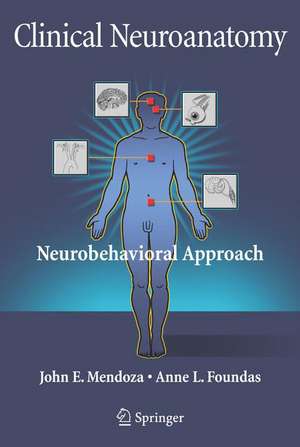Clinical Neuroanatomy: A Neurobehavioral Approach
Autor John Mendoza, Anne Foundasen Limba Engleză Hardback – 12 dec 2007
| Toate formatele și edițiile | Preț | Express |
|---|---|---|
| Paperback (1) | 612.89 lei 6-8 săpt. | |
| Springer – 29 oct 2010 | 612.89 lei 6-8 săpt. | |
| Hardback (1) | 674.42 lei 6-8 săpt. | |
| Springer – 12 dec 2007 | 674.42 lei 6-8 săpt. |
Preț: 674.42 lei
Preț vechi: 793.43 lei
-15% Nou
Puncte Express: 1012
Preț estimativ în valută:
129.06€ • 134.58$ • 107.27£
129.06€ • 134.58$ • 107.27£
Carte tipărită la comandă
Livrare economică 21 martie-04 aprilie
Preluare comenzi: 021 569.72.76
Specificații
ISBN-13: 9780387366005
ISBN-10: 0387366008
Pagini: 704
Ilustrații: X, 704 p.
Dimensiuni: 178 x 254 x 37 mm
Greutate: 1.36 kg
Ediția:2008
Editura: Springer
Colecția Springer
Locul publicării:New York, NY, United States
ISBN-10: 0387366008
Pagini: 704
Ilustrații: X, 704 p.
Dimensiuni: 178 x 254 x 37 mm
Greutate: 1.36 kg
Ediția:2008
Editura: Springer
Colecția Springer
Locul publicării:New York, NY, United States
Public țintă
Professional/practitionerCuprins
The Spinal Cord and Descending Tracts.- The Somatosensory Systems.- The Cerebellum.- The Brainstem.- The Cranial Nerves.- The Basal Ganglia.- The Thalamus.- The Limbic System/Hypothalamus.- The Cerebral Cortex.- The Cerebral Vascular System.- Neurochemical Transmission.
Recenzii
From the reviews:
"Clinical Neuroanatomy: A Neurobehavioral Approach is an outgrowth of seminars requested by neuropsychology interns and residents … . Readers will be impressed by the authors’ attention to explaining the limitations of current anatomical and physiological knowledge and reasons for the often confusing overlapping descriptions of various structures. … the work remains a laudable effort and worthy of consideration, not only by neuropsychologists but also as a valuable addition to one’s reference library by all psychologists who intend to work in health care." (John E. Carr, PsycCRITIQUES, Vol. 53 (31), 2008)
"This book describes the role of both higher cortical and subcortical structures in understanding neurological deficits. … Students and clinicians in neuropsychology are the primary audience, but the book is also relevant for ‘behavioral and traditional neurologists, neuropsychiatrists, and others who have an interest in exploring the mysteries of brain-behavior relationships’ … . helps readers to understand brain structure and function from both the vantage point of normal behavior and pathology." (Gary B Kaniuk, Doody’s Review Service, October, 2008)
"Tulane Medical School clinical neuropsychologist Mendoza and behavioral neurologist Foundas team up to provide an in-depth overview of higher-order functions, their anatomical and neurochemical substrates, pathology, and theories of functional brain organization. … An outgrowth of seminars to neuropsychology interns and residents … . It is also suitable for other clinicians who work with the neurologically impaired." (SciTech Book News, June, 2008)
"Clinical Neuroanatomy: A Neurobehavioral Approach is an outgrowth of seminars requested by neuropsychology interns and residents … . Readers will be impressed by the authors’ attention to explaining the limitations of current anatomical and physiological knowledge and reasons for the often confusing overlapping descriptions of various structures. … the work remains a laudable effort and worthy of consideration, not only by neuropsychologists but also as a valuable addition to one’s reference library by all psychologists who intend to work in health care." (John E. Carr, PsycCRITIQUES, Vol. 53 (31), 2008)
"This book describes the role of both higher cortical and subcortical structures in understanding neurological deficits. … Students and clinicians in neuropsychology are the primary audience, but the book is also relevant for ‘behavioral and traditional neurologists, neuropsychiatrists, and others who have an interest in exploring the mysteries of brain-behavior relationships’ … . helps readers to understand brain structure and function from both the vantage point of normal behavior and pathology." (Gary B Kaniuk, Doody’s Review Service, October, 2008)
"Tulane Medical School clinical neuropsychologist Mendoza and behavioral neurologist Foundas team up to provide an in-depth overview of higher-order functions, their anatomical and neurochemical substrates, pathology, and theories of functional brain organization. … An outgrowth of seminars to neuropsychology interns and residents … . It is also suitable for other clinicians who work with the neurologically impaired." (SciTech Book News, June, 2008)
Textul de pe ultima copertă
The collaboration of a clinical neuropsychologist and a behavioral neurologist, Clinical Neuroanatomy expands upon similar texts by offering an exceptionally extensive review of higher cortical – behavioral functions and their anatomical substrates. While a major text for students and clinicians in neuropsychology, it is highly relevant for behavioral and traditional neurologists, neuropsychiatrists, and others who have an interest in exploring the mysteries of brain-behavior relationships.
This book begins with a traditional review of the basic internal and external morphology, major nerve and fiber tracts, behavioral correlates, and clinical syndromes associated with spinal cord, brain stem, and cerebellum designed to reacquaint students and practicing clinicians with the functional anatomy of the subtentorial central nervous system. However, as the text was specifically geared to meet the needs of those practitioners whose primary interest is in what might be termed "higher order cognitive-behavioral function," the main focus of the text is on the brain itself. Borrowing heavily from a Lurian tradition, the central chapters reflect an attempt to offer more detailed, integrated, and, at times, theoretical models of cortical systems and their internal organization. Additional chapters highlight vascular anatomy and associated pathology, as well as neurochemical systems and their potential clinical relevance. The authors’ teaching style enlivens the material with clinical examples and welcomed touches of subtle humor.
-Nearly 300 illustrations help identify key structures and pathways, as well as providing clinical and pathological examples
-Text emphasizes the suspected roles of CNS structures in normal behavior and common consequences of lesions affecting these structures.
-Throughout the text, assessment techniques and guidelines are provided to aid in the examination of the various functional systems.
-Separate sections review the basics of bioelectric and neurochemical transmission at the neuronal and synaptic level.
-Tables, footnotes, and an extensive glossary aid the reader in retaining, understanding, and finding points of particular interest.
This book begins with a traditional review of the basic internal and external morphology, major nerve and fiber tracts, behavioral correlates, and clinical syndromes associated with spinal cord, brain stem, and cerebellum designed to reacquaint students and practicing clinicians with the functional anatomy of the subtentorial central nervous system. However, as the text was specifically geared to meet the needs of those practitioners whose primary interest is in what might be termed "higher order cognitive-behavioral function," the main focus of the text is on the brain itself. Borrowing heavily from a Lurian tradition, the central chapters reflect an attempt to offer more detailed, integrated, and, at times, theoretical models of cortical systems and their internal organization. Additional chapters highlight vascular anatomy and associated pathology, as well as neurochemical systems and their potential clinical relevance. The authors’ teaching style enlivens the material with clinical examples and welcomed touches of subtle humor.
-Nearly 300 illustrations help identify key structures and pathways, as well as providing clinical and pathological examples
-Text emphasizes the suspected roles of CNS structures in normal behavior and common consequences of lesions affecting these structures.
-Throughout the text, assessment techniques and guidelines are provided to aid in the examination of the various functional systems.
-Separate sections review the basics of bioelectric and neurochemical transmission at the neuronal and synaptic level.
-Tables, footnotes, and an extensive glossary aid the reader in retaining, understanding, and finding points of particular interest.
Caracteristici
Attempts to bridge the gap between the study of neuroanatomy and behavioral neurology/neuropsychology Initially derived from a series of lectures given to and, hence conceived as, a review of functional neuroanatomy for students of clinical neuropsychology While most functional neuroanatomical texts provide what might generally be considered a more limited treatment of the brain itself, here cortical and subcortical systems are clearly the main focus of the book Provides readers not only with the clinical correlates of neuroanatomical structures and/or pathological changes, but with theoretical models for understanding how and why one might account for those behaviors Provides a general review of the cerebrovascular system and major neurochemical transmitters Includes a substantial Glossary to facilitate a quick review of potentially unfamiliar terms or concepts












